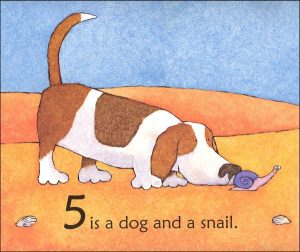Series: Book Ideas
3 Children’s Books that Build an Understanding of Equivalency

Long before young children are writing equations with the equal sign, they are exploring how amounts that look different can actually be equivalent.
Ideas about equivalence develop through everyday, concrete experiences that require children to find something that is the same as something else. Imagine a child figuring out how to fill a space in a block structure when the desired shape is not available (two isosceles right triangle blocks are the same as a square block) or sharing colored candies with a sibling (my 3 reds and 1 yellow are the same as your 2 reds and 2 yellows).
The following books offer engaging visual representations of equivalence—in the form of balance and equivalent representations of numbers.
-
Balancing Act by Ellen Stoll Walsh
This animal tale of mice on a seesaw is one of our favorites. Two mice, one on each side, balance just fine on the seesaw they are playing on. But when you begin to add more colorful animals to each side, you get different results.
Balance is a powerful, intuitive metaphor for equivalence. You can use a kinesthetic approach and have children extend their arms to look like a seesaw. They can act out what happens in the story as animals come and go from the seesaw. Draw children’s attention to the idea that if you have a balanced seesaw and change only one side, then the two sides are no longer equal and the seesaw will tilt. However, making the same change to both sides maintains a balance.
A pan balance scale and small animal toys is a great way for children to continue exploring this idea of equivalency.
-
Twelve Ways to Get to Eleven by Eve Merriam
This book by poet Eve Merriam introduces a perplexing problem: Where did 11 go? The story leads you to find 11 on each turn of the page, but in many different ways. For instance, out of a magician’s hat you find four banners, five rabbits, a pitcher of water, and one bouquet of flowers. As you discover many collections of 11 things, you realize that all of the 11-collections are equivalent amounts, even if they are made up of vastly different things.
Make your own class book of Many Ways to Get to X. Select a target number and have children draw or make collage pictures that represent that same number in different ways. Reinforce the idea that even though each page looks different, they all show the same number of things.
-
One is a Snail, Ten is a Crab by April Pulley Sayre
 This silly counting book tallies up the number of feet of various animals. It begins with a snail, which only has one “foot,” and then goes on to a human with two feet, a dog with four feet, and so on, up to a crab with ten feet. Larger numbers are represented in more than one way such as “40 is four crabs…or ten dogs.” The illustrations of animals playing at the beach keep the book fun and invite you to imagine many wacky combinations of animal feet.
This silly counting book tallies up the number of feet of various animals. It begins with a snail, which only has one “foot,” and then goes on to a human with two feet, a dog with four feet, and so on, up to a crab with ten feet. Larger numbers are represented in more than one way such as “40 is four crabs…or ten dogs.” The illustrations of animals playing at the beach keep the book fun and invite you to imagine many wacky combinations of animal feet.In the primary grades, have children write their own Feet Riddles, such as
- If you have 3 crabs and 2 dogs, how many feet?
- If you put 2 insects with me, there are 20 feet. Who am I?
- There are 11 feet. There are no crabs and no humans. Who are we?
- 2 spiders’ feet are equal to a crab plus me. Who am I?